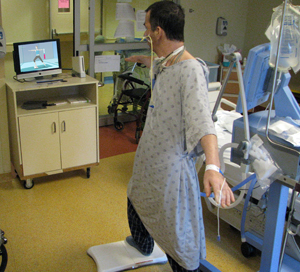Mobilizing patients is common practice, demonstrated in hospitals and rehab centres across the province, but it's rarely seen inside an intensive care unit and even more seldom carried out by not just one staff member but the entire team.
"We have a culture of early mobilization in the Medical Surgical Intensive Care Unit (MSICU)," says Vincent Lo, Physiotherapist, MSICU. "I know that patients in intensive care at TGH have been walking on the unit since the eighties."
 Practice, it seems, makes perfect as the unit's two physiotherapists, Vincent and Nathalie Côté, are still getting the patients up and about as early as the day following their surgery or admittance into the unit.
Practice, it seems, makes perfect as the unit's two physiotherapists, Vincent and Nathalie Côté, are still getting the patients up and about as early as the day following their surgery or admittance into the unit.
While the tradition has been continuing for decades now, the practice is anything but dated. Patients are now using treadmills and even using Nintendo Wii's Fit and Sport games to ward off deconditioning and improve recovery. Even patients who cannot support themselves are connected to a standing sling hovering over the treadmill that partially supports their weight while allowing them to move and use their muscles.
"But it's important to realize that this is not just a physiotherapist initiative," says Nathalie. "This is reinforced by the whole staff. Nurses often take patients for walks and get them moving without us there, leaving more complicated cases for Vince and I."
The complicated cases involve managing the multiple lines common in ICU patients. Nathalie and Vincent will get patients up and walking even if they are still vented by an endotracheal tube (ET tube or breathing tube).
Nathalie explains that seeing patients walking with an ET tube is "such a shock to the groups that shadow us. It's a more flimsy tube that can easily come out but it is definitely possible to ambulate a patient who is using one. And it means that we don't have to wait for them to be trached before we can start mobilizing."
And there are a lot of shadows – people from care centres around the GTA and as far as Brazil and Singapore have come to learn about our MSICU's mobilization techniques.
There are a lot of benefits to be reaped by getting patients up and moving – length of stay can be shortened, patients may be liberated from devices sooner, they also interact more with staff and family while they are in hospital, (such as ventilators), but perhaps most importantly, they may be able to get home sooner and in better shape to resume their daily lives outside of the hospital.
"Once patients are feeling healthy, they look better, they feel better and they show decreased delirium and confusion because they're oriented. It impacts on all levels, not just the physical," says Vincent.
